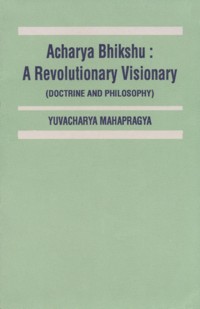It was several years ago when Acharyashri was on a visit to Jaipur. He met Dr. Sampurnanand, the then Governor of Rajasthan. He said, "Acharyashri, the word dharmanirpeksha (secular) has misled the common people. We should, therefore, have a different translation of 'secular state'." Later on, while walking through Uttar Pradesh, Acharyashri came to Lucknow where he again met Dr. Sampurnanand, who was then the Chief Minister of Uttar Pradesh. Again they discussed the same topic but did not change the translation of the word 'secular'. Shri Rajiv Gandhi as Prime Minister came to Anuvrat Bhawan to meet Acharyashri. Acharyavar said to him, "The Constitution of India interprets 'secular state' as dharmanirpeksha raj'ya which is not correct." On the Prime Minister's desire to know the correct interpretation of 'secular state', Acharyavar suggested the expression sampradaya/pantha nirpeksha rajya (non-sectarian state).
Acharya Bhikshu has very explicitly explained sampradaya nirpeksha dharma. According to him dharma is not equated with any sect, creed, mode of worship or dress style. It is spiritual in nature; it is purity of soul. Dharma has two aspects: practical and spiritual. Practical dharma is linked to sect, creed, mode of worship or dress style. But spiritual religion transcends the bounds of any country, age etc.
A general requirement of practical religion is that a religious man should engage himself in religious practice only after carefully ensuring that the ground he sits on is clean and devoid of any sentient being. Marudeva deviated from the norm. She was riding an elephant in an open seat. With the cessation of all physical consciousness she became a liberated soul. Chakravarti Bharat saw his real self and became omniscient while sitting in his glass palace, wearing regal robes. These events and life stories confirm the plausibility of these two aspects of religion.
Practical religion has an organisational aspect. In this form religion gets institutionalised. The spiritual form of religion is quite individualised. The practical manifestation of religion is never universal. It follows diverse ways. As an outcome we have multiplicity of sects, modes of worship and dress styles. Some thinkers have conceived of a single religion and a single government for the world. But there cannot be a single practical religion. It will always have diverse faiths and diverse arguments which cannot be integrated. They cannot be linked in the same chain.
The non-sectarian universal religion propounded by Acharya Bhikshu is spiritual or inner religion. He said that a person's pure or unblemished actions performed in any place or time constitute religion. Pure or unblemished actions are characterised by good soul-tint, good affective state of the mind. This is also the meaning of dharma. An earthbody is not a follower of any sect. It is not a Jain or a Buddhist or a Vaishnav or a Christian. Even then it has the element of religion in it. This precept of Mahavir is at the bottom of the concept of universal religion. A good affective state of the mind becomes religion irrespective of the class or location of a sentient being. An earthbody, on account of his good affective state of the mind, secures for himself the tenure of the higher level being, i.e., a human being. A good affective state of the mind is the religion of an earthbody. What religion is it? It is universal religion.
Actually, religion cannot have two aspects. If religion is truth, it cannot have two forms because truth is indivisible. Truth is the same for every one; similarly, religion will also be the same for every one and that religion will be the good affective state of the mind.
There is one truth but there have come into being several scriptures. Kumaril raised a question: What text can be held to be authentic when there is a multiplicity of phraseology? How can inter-scriptural differences be explained when the propounder is omniscient. Conversely, if there are differences among scriptures, how can the propounder be omniscient? Again, Kumaril asks: If religion is truth, how can there be differences, and if there are differences, how can religion be truth? In order to solve this riddle, we will have to subscribe to the concept of "One Truth" and "One Religion". As different propounders wrote different scriptures, they came out with different concepts of religion. Acharya Bhikshu's universal religion is the same for all. Every being is capable of good pursuit. One of the properties of Kshayopasham (attainment of purity through the destruction cum suppression of certain, karmas) is that it is present in every being of the world. Kshyopasham is related to nirjara (dissociation of karmas). Every being is capable of nirjara. Where there is nirjara, there must be religion.
In Acharya Bhikshu's time there was prevalent a principle in Jain tradition which said: A person with wrong insight cannot devote himself to the attainment of salvation, nor can he devote himself to religion. Acharya Bhikshu did not give recognition to this principle. He said: A person may have true spiritual insight or false spiritual insight; he may be entitled to the first stage of purification (प्रथम गुणस्थान) or the fourth or the fifth stage of purification, but every one is equally entitled to good affective mental state and good soul-tint. He further said that we cannot restrict good affective mental state and good soul-tint only to those who have true spiritual insight, thereby excluding people with false insight from possessing them. He established this principle by citing several events and examples. He wrote:
Emperor Shrenik's son, Megha Kumar was an elephant in his previous birth. How was he born a human being? The answer is that he limited the period of the cycle of birth and death. But how did he do this? Without nirjara (dissociation of karmas) the period of the cycle of birth and death cannot be limited.
Religion has two aspects: sanvar dharma (in which there is cessation of new karmic bondage) and nirjara (dissociation of old karmic bondage). The practice of sanvar dharma is possible at a higher stage, while any one can practise nirjara. There was an ascetic who did not have true spiritual insight. He practised austerities and through that he attained Vibhangaagyan. Vibhangaagyan is extra-sensory perception which cannot be attained without good end, good soul-tint and good intention. Good end, good affective mental state and good soul-tint constitute religion. It is pure or unblemished conduct. It results in nirjara or purification of the soul.
In the modern age fanaticism has become rampant and is giving rise to agitation and conflict. The so-called religious people spread unimaginable frenzy in the name of religion. They would say that there is no religion independent of sect. Acharya Bhikshu did not devalue sect. He recognised its value in proportion to its usefulness, but he did not put any worth on sect shorn of religion and never let sect get the better of religion. The nucleus of his thought was agam - Mahavir's discourses. Mahavir found fault with the attitude of those who said: Come to my sect and you will be liberated, otherwise not. The recognition of religion beyond sect is no ordinary, intellectual feat.
Acharya Bhikshu in his exposition of universal religion quoted Mahavir:
- A man has scriptural knowledge, but is devoid of right conduct.
- A man has right conduct, but is devoid of scriptural knowledge.
- A man has both scriptural knowledge and right conduct.
- A man has neither scriptural knowledge nor right conduct.
One who does not have scriptural knowledge, i.e., one who has false insight but who has right conduct is partly devoted to the pursuit of salvation. This is the manifesto of spiritual religion. A person who is not a follower of Jainism or who does not have true spiritual insight, and yet leads a life of right conduct and propriety, is partly devoted to the pursuit of salvation. This acceptance is the acceptance of the liberal spirit of religion.
In support of the claim that a person having false attitudes is capable of right conduct Acharya Bhikshu cited the example of Ashruta Kevali who had never heard or learnt anything about religion but who by his inner cleanliness and purity succeeded in the sublimation of consciousness and in becoming omniscient (केवली), thus attaining the highest stage in spiritual development.
Marudeva had gone to Rishabh to meet him as her son, not to listen to his preaching and she got liberated. She was riding an elephant in an open seat. "Marudeva has become liberated" - this revelation of Rishabh stunned every one. The universal aspect of religion is not contingent on external factors. Sect, mode of worship etc. are tradition-bound. The non-sectarian aspect of religion has not been properly understood. Therefore there is so much intolerance in religious matters. If we had known and understood the universal aspect of religion, we would not have witnessed so much sectarian frenzy.
Acharya Bhikshu gave due recognition to sect and tradition. He never disregarded sect. He was fully familiar with the utility of sect, but he never considered it proper to put religion within the bounds of sect. We should place these two aspects of religion in perspective. Sect should become a means to understand and practise true religion, but it should not imprison religion within its folds. It is true that a layman does not feel attached to his faith without such external associations as 'our sect', 'our code of conduct', 'our dress style' and 'our identity.' But what actually happened was that man got so much imprisoned in a particular sect, code of conduct and dress style that he was unable to see religion beyond the bounds of these associations. This one-sided attitude to religion was what Acharya Bhikshu argued against.
He propounded the universal aspect of religion. Its denning feature is: If a person with a false attitude performs spiritual practices, it is in accordance with the sayings of Arhat and is a means to the path of salvation.
 Yuvacharya Mahaprajna
Yuvacharya Mahaprajna
